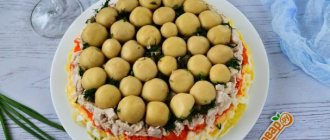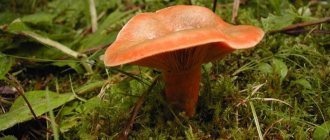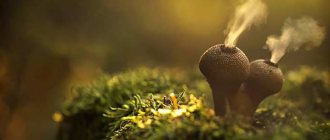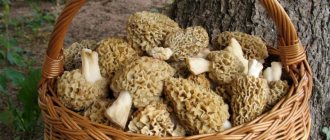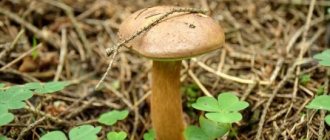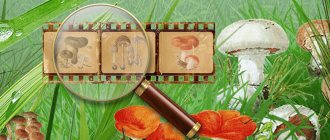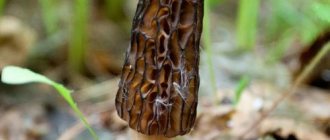Being a mushroom picker is quite an interesting hobby, which involves a forest adventure and walks in the fresh air. But in order for this activity not to cause harm, you need to have a good understanding of mushrooms in order to easily identify edible ones.
There are a huge number of edible species. They have a special aroma and taste. Many of the representatives are considered delicacies, and finding them is a great success.
Mushrooms allowed for consumption are divided into classes, taking into account their taste and nutritional value. Many are incredibly valuable due to the large amount of nutrients they contain.
Mushroom “meat” requires the presence of useful substances such as proteins, carbohydrates, and is also rich in vitamins and minerals. It also contains enzymes that affect the digestibility and functioning of the digestive system. Champignons, which are considered the most consumed by humans, exhibit especially good properties.
Clustering of edible mushrooms implies the presence of the rarest specimens, which are not so easy to find. Finding a rare mushroom that has little nutritional value is still considered a great joy for mushroom hunters.
Here you can see a list of the most famous edible mushrooms that are of particular value to mushroom pickers. However, it is necessary to clearly know the distinctive features of the species so as not to confuse them with inedible ones.
Polish mushroom
Belongs to the boletus species. Previously, it was imported to Russian markets from Poland. This is where the name came from. It is considered a valuable product. It is boiled, fried, dried.
Appearance similar to porcini mushroom. At the beginning of growth, the cap is wrapped. It unfolds when the wearer grows to approximately 12 cm.
Rarely found in nature. Grows in acidic soils in areas with coniferous forests. Loves beech, oak and chestnut. Found in lowlands, foothills, and at the foot of trees.
Autumn honey fungus
Can be used in any form. The structure of the product is dense (it needs to be boiled for a long time) with a pronounced mushroom aroma, but it’s not for everyone.
The cap is first convex, then expanded, 2–15 cm in diameter. The color is sandy-orange, brown. Towards the center the color becomes brighter. There are small scales along the edges. The pulp is whitish.
Autumn honey fungus is a parasitic mushroom. It grows in a friendly family on trees and stumps. Prefers mixed forests consisting of birches, aspens, oaks and pines.
Edible raincoat
Edible mushroom from the champignon genus. Suitable for any culinary dishes. It has a pronounced mushroom taste. The mushroom is collected at the beginning of its growth. As it grows, it becomes very tough.
The color of the mushroom is light, almost white. Has brown inclusions (scales). As they approach the center of the cap, the scales become darker. The fruit part is 2–5 cm in diameter.
Grows in coniferous and mixed forests. Prefers wet (rainy) weather. Ripening time: early summer / late autumn.
Ringed cap
It is predominantly distributed in Europe. He has many poisonous counterparts. Grows from July to September in damp forest areas. More often found near blackberry bushes and under spruce trees.
The mushroom's cap is similar to a cap, up to 12 cm in size. The color ranges from a yellowish tint to brown. When cut, white flesh is visible. When exposed to oxygen, it quickly turns yellow.
Kozlyak
An edible representative of the boletus genus. It is also called reshetnik, flywheel. Delicious, slightly slippery mushroom. It is easy to confuse the goat mushroom with its inedible brother, the pepper mushroom.
The cap is 3–12 cm, cushion-shaped, spongy, porous, shiny. It feels sticky and smooth to the touch. Color - light brown, brown.
Loves coniferous forests and acidic soils. Often grows in symbiosis with pine. There are single “tenants” and entire families.
Porcini
One of the most valuable noble mushrooms. Other names: boletus, yolk. The mushroom is edible in any form. It has a rich, dense taste.
The stem of the mushroom is thick, dense, and beige-white in color. The cap is brown, straightened, up to 50 cm in diameter.
Peak collection occurs in late spring and early summer. But it is also found in the fall (in warm, humid weather). Loves deciduous and coniferous forests, often growing near moss and lichen. Prefers loamy soil and sandstones. Distributed throughout Russia.
Common dubovik
An edible type of boletus. Valuable mushroom. Similar in appearance to its white counterpart. Grows mainly in oak forests. Sometimes found in coniferous and mixed forests.
Oak wood is collected throughout the summer and early autumn. The best time is after the rain. The cap of the mushroom is large - up to 20 cm, and shaped like a dome. When it grows, it opens up and becomes like a pillow. The surface is matte, velvety. Color - gray-brown.
Does not lose elasticity during cooking. Has a delicate mushroom aroma.
Bruise
Edible but unusual mushroom. In appearance it is beige, but when pressed or cut it begins to acquire a bright blue color. The blue substance secreted by the fungus is safe for humans.
The cap is convex, evenly colored in a sandy shade. There is a thickening on the bottom of the leg. The pulp is brittle and loose.
Grows alone in sandy soil. Loves oak groves or conifers. The collection begins in mid-summer and continues until the end of the warm season. The representative is listed in the Red Book.
boletus
A beautiful, edible mushroom. Has a pronounced mushroom aroma. Suitable for any dish.
The lumpy, matte cap is represented by a hemisphere with a diameter of 5–15 cm. The color is gray-light brown, darkening towards the center. May be confused with gall fungus. It is not poisonous, but very bitter.
Boletus mushrooms are collected near deciduous trees. They grow on the edges and in lowlands.
Gray row
An edible mushroom with a bright taste. It has other names - serushka, pine tree. It is eaten after heat treatment (after boiling). Dense mushroom base without bitterness.
Grows in symbiosis with pine trees. Loves sandy soil under pine and mixed forests. Does not disdain old plantings.
The hat is average - 4–12 cm. Sometimes it grows up to 20 cm. Color - gray with a slight purple tint.
Common chanterelle
Edible bright orange mushroom. It is also called “cockerel”. Difficult to confuse with other specimens. Initially, the cap has a slight convexity, then becomes irregular in shape and curls into a funnel. Diameter - 4–7 cm.
The taste is mushroom, dense. The consistency of the fruiting body is fleshy and compacted. During heat treatment, it loses a little color, but retains moisture.
It grows in groups from June to November in coniferous and mixed forests. Often found near moss and in needles.
Lilac-legged rower
An edible mushroom from the row family. They are among the good mushrooms, that is, they are collected and eaten. The mushroom got its name because of the corresponding color of its stem.
The cap is white with a slight purple tint (6–15 cm), the leg is purple. Sometimes there are giants up to 25 cm.
A meaty, dense mushroom. The taste is sweetish, with fruity notes. No strong mushroom taste. Grows in summer and autumn in meadows and forests.
Oiler yellow-brown
Tubular, edible representative of butter. Other names: swamp grass, pestle. Prefers symbiosis with pine, but is also found in mixed forests. Grows on sandstone and among fallen pine needles.
The cap is small - 3–10 cm in diameter. Flat shape. Color - brown-cream.
The mushroom is fried, boiled, marinated and salted. The quality of the product is low, but many value it for its specific, oily taste.
Golden scale
A bright, easily recognizable mushroom. Grows in groups. Loves living but fallen trees.
Conditionally edible mushroom. It has an incomparable, slightly sweet taste. Experienced mushroom pickers collect it, heat it and eat it. However, many people complain of stomach pain after consuming the product.
The hat is shiny. It is bright orange with dark spots. The shape resembles a convex bell. Diameter - 5–10 cm.
Yellow hedgehog
Often called the chanterelle's cousin. Has high taste qualities. Easy to prepare - no need to boil or soak.
Mushroom specimens are reddish in color with a wavy cap up to 15 cm in diameter. There are small spines under the cap.
The representative grows in humid forests (mixed, deciduous, coniferous). Prefers to grow in groups.
Variegated umbrella
Edible, very tasty mushroom. But only experienced mushroom pickers collect it, as it can be confused with its poisonous counterparts - fly agarics.
The cap is initially ovoid, but as it grows it opens up and becomes huge. Some specimens grow up to 50 cm.
Grows on lawns, forest edges, paths. Loves oaks, pines and other coniferous trees.
Amanita pearl
An edible mushroom distributed throughout the northern hemisphere. Collection occurs from spring to late autumn. There are single specimens, but more often the mushrooms settle in groups. Loves clearings and light areas in mixed forests.
The cap is 5–15 cm, yellowish-cream, brighter in the center. The pulp is brittle (turns pink when cut, then turns red), without much taste. The mushroom aroma is subtle.
Green moss
Famous edible mushroom. Grows under broad-leaved trees (likes birch and willow). Moss mushrooms are harvested in the autumn - from August to November.
The hat is brown (up to 8 cm), matte. The leg is yellowish or greenish. The sponginess is porous, yellow.
Volnushka white
Conditionally edible, not very tasty mushroom. Commonly called whitefish. Accordingly, it has a white color and furry scales on the cap (its diameter is up to 6 cm). When cooking, the volushka is soaked and boiled several times.
The mushroom grows next to birch trees. The representative is most often collected by Russian mushroom pickers. In Europe it is ignored.
fly agaric
This is the leader of the inedible mushrooms. Despite its beautiful coloring, it is strictly forbidden to eat. To draw it, you need to choose only bright shades of pencils. It is better to use watercolors. Additionally, you will need a black gel pen and an eraser. Let's get to work. We will depict a family of three representatives of the species.
- We draw three contours of future legs. The tallest one should be in the center.
- Adding hats. Fly agarics of different sizes have different shapes. For the central one, we make a circle with wavy edges at both the top and bottom. For the left mushroom, draw a circle and add an arc on top, dividing the entire cap into two parts. The top half is much smaller than the bottom. For the right one - a small elongated oval.
- Adding details. It is necessary to show folds on the legs: some in the center, others in several rows at the bottom. Add plates under the mushroom caps.
- We draw white dots on the head using circles of different sizes. Moss can be depicted below. Now everything needs to be outlined with a black pen. After it dries, remove all pencil lines.
- Let's color the picture. We make the legs gray. The cap plates are the same color. We use brown to show shadows. The hat consists of three layers of color. The top is orange. The edges are burgundy and the central part is red. We correct everything with smooth transitions. Paint the moss with a dark green shade. The work is completed.
White King
Let's start with the simplest and most popular option. You can draw with your child. To do this, you should prepare: simple and multi-colored pencils, plastic.
- We draw the contours of the mushroom. We make the head semicircular, and add an elongated oval at the bottom. This is a leg.
- Next we draw the same one, only smaller in size. We are engaged in drawing contours and details. At the bottom of the cap we draw an arc separating its top. The line indicates the location of the beginning of the leg.
- Make the contours of the small mushroom clearer. We remove all auxiliary dashes. For a beautiful look, add grass. It may slightly overlap the main part.
- Now you can start coloring. The tops will be brown. Show a little light highlight. We make the base gray and the grass green. Paint the bottom of the cap with pale yellow paint. The drawing is ready.
How to draw a fox?
Chanterelles are different in appearance from most other mushrooms. It may be yellow or orange. They have an irregular shape: the edges are wavy, curved towards the bottom. The cap is almost completely fused with the stem. Such mushrooms grow in almost every forest. More often found near oak, birch or pine. Having learned a few distinctive features, you can begin to depict it on paper in stages.
- We make the outline of the mushroom. To make it beautiful, you need to draw two auxiliary lines: one horizontal, the second vertical, slightly tilted to the side.
- We add two slashes to the vertical line. This will be the base of the leg. Now we draw two lines up, gradually expanding them. The result is a shape similar to a cup.
- To give the top its own shape, draw an elongated and uneven oval. It should protrude slightly to the sides.
- We remove all auxiliary lines. Under the cap we draw, a little with a slight slope, a lot of vertical stripes. Draw the grass using sharp triangles.
- All that remains is to color everything. We outline the outline in brown, lightly shading the mushroom itself. Make the sides more saturated. Add orange to the top of the leg. The grass is green. This is how easy it is to draw a fox with a pencil, following a step-by-step plan.
Characteristics of edible mushrooms and their description
Among the noble representatives of edible, tasty and healthy mushrooms, there is a special group, which is usually characterized by one word “toadstools”, because they are all poisonous or deadly poisonous, there are about 30 species. They are dangerous because they usually grow next to edible ones and often look similar to them. Unfortunately, only a few hours later it turns out that a dangerous mushroom was eaten, when the person was poisoned and ended up in the hospital.
To avoid such serious troubles, it would be useful to look again at the photos, names and descriptions of edible forest mushrooms before going on a “quiet hunt”.
You can start with the first category, which includes the most noble, high-quality mushrooms with the highest taste and nutritional qualities.
Porcini mushroom (or boletus) - it is given the palm, it is one of the rarest among its relatives, the beneficial properties of this mushroom are unique, and the taste is the highest. When the mushroom is small, it has a very light cap on top, which changes its color to yellowish-brown or chestnut with age. The underside is tubular, white or yellowish, the flesh is dense, the older the mushroom becomes, the more flabby its flesh becomes, but its color does not change when cut. This is important to know, since the poisonous gall mushroom is similar in appearance to the white one, but the surface of the spongy layer is pink, and the flesh turns red at the break. In young boletus, the legs have the shape of a drop or a barrel, with age it changes to cylindrical.
It is most often found in summer, does not grow in groups, and can be found in sandy or grassy meadows.
Boletus is a delicious mushroom, rich in microelements, known as an absorbent that binds and removes harmful toxic substances from the human body. The cap of the boletus is a muted brown shade, convex, reaching a diameter of 12 cm, the stem is covered with small scales, and widened towards the base. The pulp does not have a specific mushroom smell; when broken, it acquires a pinkish tint.
Mushrooms love moist soil, you should go for them in a birch grove after a good rain, you need to look right at the roots of birch trees, they are found in aspen forests.
Camelina is a mushroom that got its name due to its special carrot-red color, the cap is an interesting funnel-shaped, with a depression in the middle, circles are visible from the depression to the edges, the lower part and the stem are also orange, the plastics turn green when pressed. The pulp is also bright orange, gives off a light resinous aroma and taste, the milky juice released at the break turns green, then turns brown. The taste of the mushroom is highly valued.
Prefers to grow in pine forests on sandy soils.
The real milk mushroom is considered and called “the king of mushrooms” by mushroom pickers, although it cannot boast that it is suitable for use in various processing: basically, it is eaten only in salted form. The cap at a young age is flat-convex, with a slight depression, turning into a funnel-shaped, yellowish or greenish-white with age. It has transparent, glassy-like diametric circles - one of the characteristic signs of milk mushrooms. The plates from the stem extend to the edge of the cap, on which a fibrous fringe grows. The white, brittle pulp has a recognizable mushroom smell; the white juice, as it weathers, begins to turn yellow.
Next, we can continue to consider the description of edible mushrooms belonging to the second category, which may be tasty and desirable, but their nutritional value is somewhat lower; experienced mushroom pickers do not ignore them.
Oiler is a genus of tubular mushrooms, it got its name because of its oily cap, initially red-brown, then turning into yellow-ocher, semicircular with a tubercle in the center. The pulp is juicy, yellowish in color, without changing when cut.
Boletus (aspen) - while young, the cap is spherical, after a couple of days its shape resembles a plate on a stocky leg elongated to 15 cm, covered with black scales. A cut of the flesh turns from white to pink-violet or gray-violet.
Polish mushroom - belongs to the valuable, elite mushrooms, has some similarities with the porcini mushroom, its cap is chestnut-brown, first curled downwards, in adult mushrooms it curls up, becomes flatter, in rainy weather a sticky substance appears on it, the skin separates with difficulties. The leg is dense, cylindrical-shaped up to 4 cm in diameter, often smooth, with thin scales.
Speckled oak mushroom - similar in appearance to the white mushroom, but it has a slightly different color, black-brown, the stem is a pale yellowish color with reddish inclusions. The pulp is fleshy and dense, bright yellow, turning green at the break.
Common oakberry - its leg is brighter, the base is colored with a reddish tint with a light pinkish mesh. The flesh is also fleshy and dense, bright yellow, turning green at the break.
The names of edible mushrooms of the third, penultimate category are not so familiar to novice mushroom pickers, but it is quite numerous; mushrooms of this category are found much more often than the first two combined. When during the mushroom season it is possible to collect a sufficient number of white mushrooms, saffron milk caps, milk mushrooms and others, many people bypass the mushrooms, chanterelles, russula, and valui. But when problems occur with the quantity of noble mushrooms, these mushrooms are willingly collected, so you don’t return home with empty baskets.
The volnushki are pink, white, very similar to each other, the only difference is in the color of the cap, the pink volnushka has a young cap with a beard, a convex shape with red rings that fade with age, the white one has a lighter cap, there are no circles, the stem is thin, the plates are narrow and frequent. Thanks to their dense pulp, the trumpets tolerate transportation well. They require long-term heat treatment before use.
Russulas are the most common of the Russula family; more than ten species grow in Russia; sometimes they are given the poetic definition of “gems” for the beautiful, varied shades of their caps. The most delicious are russulas with pinkish, reddish wavy curved or hemispherical caps, which become sticky in wet weather, and matte in dry weather. There are caps that are unevenly colored and have white spots. The stem of russula is from 3 to 10 cm in height, the flesh is usually white and quite fragile.
Common chanterelles are considered a delicacy; the caps become funnel-shaped with age; they do not have a clear transition to unevenly cylindrical legs, tapering at the base. The dense, fleshy pulp has a pleasant mushroom aroma and pungent taste. Chanterelles differ from saffron milk caps by having a wavy or curly cap, they are lighter than saffron milk caps, and appear translucent in the light.
Interestingly, chanterelles are not worm-bearing because they contain quinomannose in the pulp, which kills insects and arthropods from the fungus. The accumulation rate of radionuclides is average.
false chanterelles do not get into the basket along with edible mushrooms ; when they become old, they acquire a pale yellow color.
They are distinguished when colonies of chanterelles with mushrooms of different ages are found:
- real mushrooms of any age of the same color;
- false young mushrooms are bright orange.
Valui - with spherical caps, which in adult mushrooms becomes convex with saggy edges, yellowish plates with brownish spots, the pulp of valuu is white and dense. Old mushrooms have an unpleasant smell, so it is recommended to collect only young mushrooms that look like fists.
Honey mushrooms are mushrooms that grow in groups of many, they grow annually in the same places, therefore, having spotted such a mushroom place, you can confidently return to it every year with the confidence that the harvest will be guaranteed. They are easy to find on rotten, rotten stumps and fallen trees. The color of their caps is beige-brown, always darker in the center, lighter towards the edges, and with high humidity they acquire a reddish tint. The shape of the caps of young honey mushrooms is hemispherical, while that of mature ones is flat, but the tubercle remains in the middle. In young mushrooms, a thin film grows from the stem to the cap, which breaks as it grows, leaving a skirt on the stem.
The article does not present all edible mushrooms with photos, names and their detailed descriptions; there are a lot of varieties of mushrooms: goats, flywheels, rows, morels, puffballs, pig mushrooms, oyster mushrooms, blackberries, bitter mushrooms, others - their diversity is simply enormous.
When going to the forest for mushrooms, modern inexperienced mushroom pickers can use mobile phones to capture photos of edible mushrooms that are most often found in a given area, in order to be able to check the mushrooms they find with the photos available on the phone as a good clue.
About me
Member of the International Association of Artists
Member of the Creative Union of Artists of Russia
Member of the Association of Portrait Painters of Russia
An artist who is always in touch!
Participant of 26 Moscow exhibitions, incl. and personal ones in the Central House of Artists
Reports about my work were filmed by such TV channels as Channel 1, BBC World, TVP1 Polish Television, Aljazeera, Ren TV, STS, etc.
Publications in art albums and newspapers ("MK", "THE MOSCOW TIMES", "Ogonyok", "Evening Moscow", etc.)
boletus
This mushroom has a high, curved stalk. The hat is thick and red. They have a spongy layer underneath. It won’t be difficult even for a child to draw it. Here is a small easy master class.
- 1 step. Let's draw a hat. To do this, draw a horizontal line. Its length is the width of the cap. From the ends of the line at the top, draw an arc.
- Step 2. We depict the leg in the form of an elongated vertical oval. That's the whole lesson. All that remains is to paint.
- Step 3. The hat can be dark brown or gray. The bottom layer is white. The pattern on the leg resembles birch bark. Everyone can imagine this tree and repeat a similar drawing, only in a smaller form.
Honey mushroom family
Small mushrooms with round caps are always arranged in groups. They grow on green meadows and stumps. Every mushroom picker loves these fragrant babies. When starting to depict these beauties, it is better to look at them in person. After all, it is so unusual for them to gather in friendly companies. But, if this is not possible, you can look at the photo and make our step-by-step lesson.
- Let's draw a cylinder - this is the future stump. We mark the location of the mushrooms with thin lines. Two will be at the bottom left, and a group of five will be at the top right on the edge of the stump.
- We thicken the legs. We draw semi-oval caps.
- Now we color the work with colored felt-tip pens. The mushrooms themselves will be light brown. Don't forget to show the skirt under the hat and on the leg. The stump is dark brown in color. The top of the cut is yellow.
- We add a little yellow to the mushroom itself, showing the transition from dark to light areas. We darken the bottom of the stem of each honey mushroom.
- Draw the roots of the stump and the grass.
You can make a drawing unique by adding just a little bit of your vision. Even following our general step-by-step master classes, each person’s paintings will be different. And that's great. After all, every video world is different.
